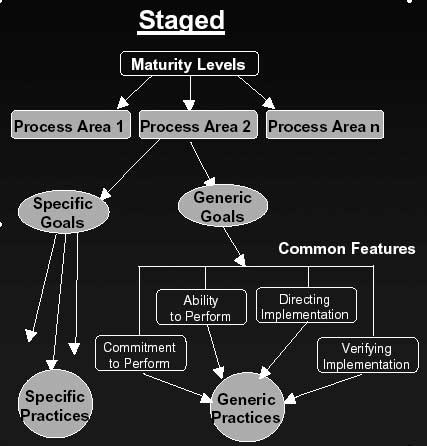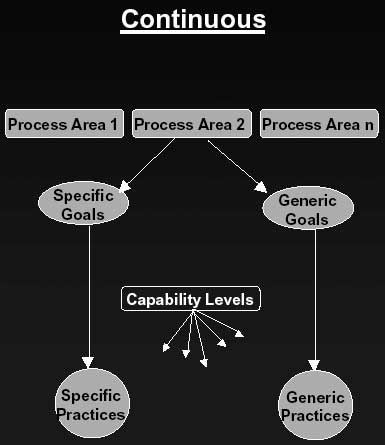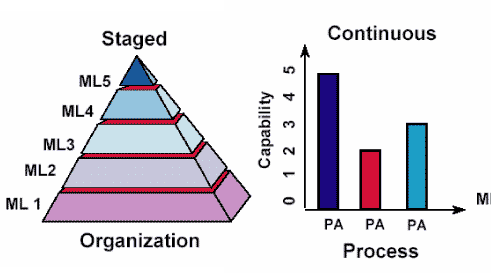
- CMMI - Home
- CMMI - Overview
- CMMI - Models
- CMMI - Representations
- CMMI - Maturity Levels
- CMMI - Capability Levels
- CMMI - Process Areas
- CMMI - Appraisals
- CMMI - Major Players
- CMMI - Summary
- CMMI Useful Resources
- CMMI - Quick Guide
- CMMI - Resources
SEI CMMI - Representations
The CMMI is structured as follows −
- Maturity Levels (staged representation) or Capability Levels (continuous representation)
- Process Areas
- Goals: Generic and Specific
- Common Features
- Practices: Generic and Specific
This chapter will discuss about two CMMI representations and rest of the subjects will be covered in subsequent chapters.
A representation allows an organization to pursue different improvement objectives. An organization can go for one of the following two improvement paths.
Staged Representation
The staged representation is the approach used in the Software CMM. It is an approach that uses predefined sets of process areas to define an improvement path for an organization. This improvement path is described by a model component called a Maturity Level. A maturity level is a well-defined evolutionary plateau towards achieving improved organizational processes.
CMMI Staged Representation
Provides a proven sequence of improvements, each serving as a foundation for the next.
Permits comparisons across and among organizations by the use of maturity levels.
Provides an easy migration from the SW-CMM to CMMI.
Provides a single rating that summarizes appraisal results and allows comparisons among organizations.
Thus Staged Representation provides a pre-defined roadmap for organizational improvement based on proven grouping and ordering of processes and associated organizational relationships. You cannot divert from the sequence of steps.
CMMI Staged Structure
Following picture illustrates CMMI Staged Model Structure.

Continuous Representation
Continuous representation is the approach used in the SECM and the IPD-CMM. This approach allows an organization to select a specific process area and make improvements based on it. The continuous representation uses Capability Levels to characterize improvement relative to an individual process area.
CMMI Continuous Representation
Allows you to select the order of improvement that best meets your organization's business objectives and mitigates your organization's areas of risk.
Enables comparisons across and among organizations on a process-area-by-process-area basis.
Provides an easy migration from EIA 731 (and other models with a continuous representation) to CMMI.
Thus Continuous Representation provides flexibility to organizations to choose the processes for improvement, as well as the amount of improvement required.
CMMI Continuous Structure
The following picture illustrates the CMMI Continuous Model Structure.

Continuous vs Staged Representations
| Continuous Representation | Staged Representation |
|---|---|
Process areas are organized by process area categories. |
Process areas are organized by maturity levels. |
Improvement is measured using capability levels. Capability levels measure the maturity of a particular process across an organization; it ranges from 0 through 5. |
Improvement is measured using maturity levels. Maturity levels measure the maturity of a set of processes across an organization: it ranges from 1 through 5. |
There are two types of specific practices: base and advanced. All specific practices appear in the continuous representation. |
There is only one type of specific practice. The concepts of base and advanced practices are not used. All specific practices appear in the staged representation except when a related base-advanced pair of practices appears in the continuous representation, in which case only the advanced practice appears in the staged representation. |
Capability levels are used to organize the generic practices. |
Common features are used to organize generic practices. |
All generic practices are included in each process area. |
Only the level 2 and level 3 generic practices are included. |
Equivalent staging allows determination of a maturity level from an organization's achievement profile. |
There is no need for an equivalence mechanism to back the continuous representation because each organization can choose what to improve and how much to improve using the staged representation. |
Which Representation is Better?
Each representation has its advantages over the other, some organizations use both representations to address particular requirements at various times in their improvement programs.
Organizational maturity is the focus of the staged representation, whereas process area capability is the focus of the continuous representation.
Organizational maturity and process area capability are similar concepts. The difference between them is that organizational maturity pertains to a set of process areas across an organization, while process area capability deals with a set of processes relating to a single process area or specific practice.
The following diagram depicts both the presentations. In this diagram, ML indicates Maturity Level and PA Indicates Process Area.
